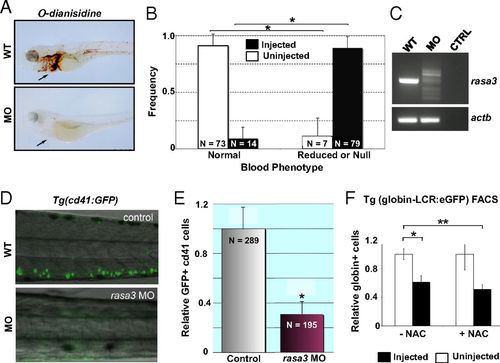- Title
-
Critical function for the Ras-GTPase activating protein RASA3 in vertebrate erythropoiesis and megakaryopoiesis
- Authors
- Blanc, L., Ciciotte, S.L., Gwynn, B., Hildick-Smith, G.J., Pierce, E.L., Soltis, K.A., Cooney, J.D., Paw, B.H., and Peters, L.L.
- Source
- Full text @ Proc. Natl. Acad. Sci. USA
|
rasa3 knockdown in zebrafish recapitulates the scat anemia and thrombocytopenia phenotype. (A) In WT embryos, abundant ¿-dianisidine positive hemoglobinized cells are seen in the heart and vessels (arrow) at 72 h postfertilization, whereas positive cells are absent in rasa3 morphants (MO). (B) Quantitation of the range of embryos containing normal and reduced or null number of hemoglobinized cells at 72 h postfertilization from control (uninjected) and rasa3 MO (injected). X ± SEM; *P < 0.05, t test. (C) By RT-PCR, abnormally processed rasa3 mRNA splice forms are found in MO compared with RNA control (CTRL) and uninjected embryos (WT). actb serves as a control of off-target effects. (D) Silencing of rasa3 results in loss of GFP+ cd41-thrombocytes (green) in the transgenic Tg(cd41:GFP) line (MO) compared with control (WT). (E) Quantitation of GFP+ cd41-thrombocytes by flow cytometry in control and rasa3 morphant (MO) embryos. X ± SEM; *P < 0.05, t test. (F) Treatment of WT zebrafish (uninjected) and rasa3 MO (injected) from the Tg(globin LCR:eGFP) transgenic line with the potent antioxidant N-acetyl cysteine (+NAC) fails to improve anemia in the rasa3 MO embryos, indicating that generation of ROS per se is not a contributing factor in the anemia. NAC, exposed to vehicle carrier only. X ± SEM; *P < 0.05; **P < 0.01, t test. PHENOTYPE:
|
|
Anemic phenotype of rasa3 morphants and expression of rasa3 in developing zebrafish. (A) rasa3 is widely expressed in the developing zebrafish embryo (Left), in contrast to the tissue-restricted expression of gata-1 to the blood island (intermediate cell mass, Right, arrow). (B) Defect in hemoglobinization is revealed in rasa3 morphants (Right) with o-dianisidine staining at 48 hpf. EXPRESSION / LABELING:
|


